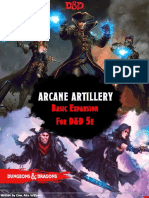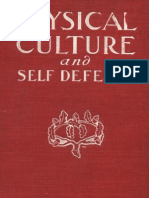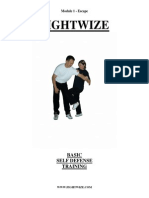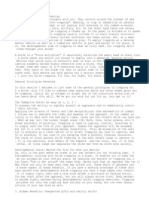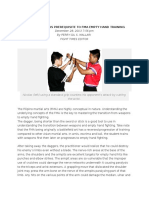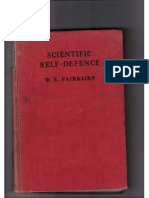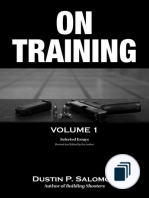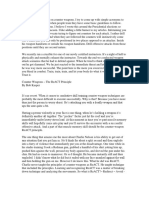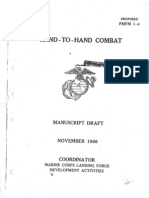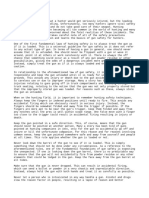Applegate
Uploaded by
cqb123Applegate
Uploaded by
cqb123Slide 1
INSTICTIVE SHOOTING
Rex Applegates Work Had Little to do with Instinct
Applegates Instinct Shooting ATSA Study Group November 15, 2008 SLIDE # 1 Rex Applegate wrote various books on individual combat using everything from empty hands to improvised weapons, impact weapons, edged weapons and firearms. He evolved a form of practical handgun shooting that he identified as Instinct Shooting. This unfortunate choice of terminology has generated endless debate and rationalization among trainers, writers and pundits since his adoption of the term. A look at the technique he evolved from the work of others before him will reveal that none of his technique involved instinct and further, techniques of today that are all the rage are derivative of his work and that of Sykes, Fairbairn and many others from the early part of the 20 th Century.
Slide 2
Applegates History
Lt., WWII Assigned to training of OSS operatives in personal combat. Assigned to work with Sykes and Fairbairn. Developed Training Protocols with Various Individual Weapons. Wrote Several Books On Related Subjects.
SLIDE # 2 Early in WWII Applegate was assigned as a training officer to an old CCC camp in north western Maryland that was converted to a military installation and subsequently became known as Camp David. Also assigned to this installation was British Army Capt. William Fairbairn. Fairbairn and his cohort Capt. Eric Sykes were former police officers in Shanghai, China during the British Colonial Period. Starting in 1919 Sykes and Fairbairn operated a police detachment that was assigned to take the fight to VCA in Shanghai. In 12 years their men were engaged in 666 shootings which resulted in 260 VCA killed, 193 wounded, 42 police officers killed and 100 wounded. 90% of the shootings were in the dark with the majority of hits made within 4 yards. Fights were over within a few seconds. There was little incidence of reloading. Both the British and the Americans used the experiences of these two men in developing a system of close combat with handguns for use by operatives assigned to intelligence and insurgent activities. During the war, Applegate was assigned to study under Sykes in England for a period. He commented that by the time the two British Captains were given their war assignments their personal relationship
had deteriorated. He also commented that Fairbairn was much more interested in knife work. Sykes was much more interested in handgun work. During his war work with the two British Captains Applegate developed a training manual which was published as the Close Combat Files of Col. Rex Applegate late in his life. Shortly after the war he wrote KILL or Get Killed which was and is still considered a seminal work in the use of personal weapons in police and military circles. He also authored books on riot control and scouting and patrolling.
Slide 3
Firearms Studies
Little Time and Resources for Training. Studied the Suitability of Handguns for the Average Student. Identified Guns for the Average Student.
SLIDE # 3 Applegate quickly realized that few candidates for the assignments to foreign stations would have any significant amount of exposure to weapons, particularly handguns. What handgun experience did exist would be in precision target shooting over known distances that generally exceeded any range a gunfight was likely to occur in. He resolved to study whether particular weapons platforms were more or less suitable to a form of shooting he referred to as Instinct Shooting. He selected 100 officers and men with varying degrees of handgun experience. He identified their level of experience and grouped them. He then exposed them to a variety of revolvers and auto-pistols. Essentially they were 2 and 4 revolvers of S & W and Colt manufacture and Government Model and Hi-Power auto-pistols. His work suggested to him that the man of average handgun experience preferred and did better with the S&W revolvers and the HiPower auto-pistol in his identified technique. He identified certain design characteristics in these design platforms as more amenable to making immediate and regular hits on the torso of a
man by those with limited experience with his identified technique across an experience spectrum. He readily acknowledged that training and diligence resident in the individual student could permit that student to become competent with any of the other design platforms. Noticeably, while identifying the Government Model as the premier fighting pistol, he put it in a class by itself because of the recoil signature and the grip design which required a modification to his technique to be successful in application.
Slide 4
ASSUMPTIONS
The Practitioner would have ample warning to respond with weapon in hand. He would be in hunter mode at the time of the encounter. He would have 1/3 second.
SLIDE # 4 Applegates technique assumed the Practitioner would begin his encounter with his gun in his hand and mentally anticipating an immediate encounter. He posited that the Practitioner would have about 1/3 second to get off his first shot upon encountering his antagonist. Applegate noted that fast draw skills were only needed by Detectives and others who moved about under circumstances where they were not immediately expecting some form of engagement. By inference, this would also apply to citizen/VCA encounters. Because of the circumstances that formulated the assumptions, it was postulated that the Practitioner would be adrenalized. It was further posited that such a condition would cause the Practitioner to use a target focus. Poor lighting would contribute to this form of focus. And that the Practitioner would have a convulsive grip on the weapon.
Slide 5
ASSUMPTIONS
Contacts would most commonly be less than 7 yards. The technique could provide acceptable results out to 17 yards. Beyond 13 yards a two handed sighted fire technique was preferable. Hits along a centerline axis of the body were acceptable.
Slide 6
TECHNIQUE
One hand shooting. Gun is placed as index in hand. Wrist and elbow locked. Target focus. Body squared to target. Gun raised to center of face. Convulsive 20# grip on gun. Paired shots on each target.
SLIDE # 6 The technique described by Applegate was not instinctive at all. The gun is in the indexed position and hits are dependant on this placed position. The wrist and elbow are locked. This is not an instinctive position and hits are dependant on the locking of these joints. With the gun indexed, the gun is raised to the center of the face and is there fore aimed while not necessarily sighted. Hits from paired shots along the centerline of the torso are dependant on the convulsive grip.
Slide 7
MOVEMENT
Square the body to the target that is off your centerline as you raise the gun to your face. No dictated foot movement technique. Always move forward.
SLIDE # 7 It is essential to the technique that the body be squared to the target. Turning was to be accomplished by moving the feet to square the body. Applegate was explicit that no set technique was to be dictated for moving the feet. Set systems could not account for the type of terrain conditions that might be existent at the time of the encounter. Experimentation with all manner of movement was encouraged. All shooting was to be done while moving forward. The rationale was that it was psychological powerful and the Practitioner could not back up faster than a bullet anyway. Forward movement involved a forward crouch and flexed knees. Shooting at moving targets requires a two handed hold.
Slide 8
Index
Slide 9
Two Hand Grip
Slide 10
Two Hand Grip
Slide 11
Push Pull
Slide 12
Mental Conditioning
In order to avoid panic in a fight the shooter should visualize he is shooting at a target that will shoot back. He must fix in his mind what he will do in a fight. Drawing, aiming and firing must be an automatic reaction.
You might also like
- Fairbairn Military Intensive Courses Compared To The IDF Krav Maga Intensive Courses100% (1)Fairbairn Military Intensive Courses Compared To The IDF Krav Maga Intensive Courses9 pages
- Sandow on physical training: A study in the perfect type of the human formFrom EverandSandow on physical training: A study in the perfect type of the human formNo ratings yet
- Army Universal Assault Rifle Steyr Semi Automatic Aug Cal 5-56-223 MM Nato ManualNo ratings yetArmy Universal Assault Rifle Steyr Semi Automatic Aug Cal 5-56-223 MM Nato Manual44 pages
- Basic Markmanship Pistol Manipulation Malfunction Drills and Range CommunicationsNo ratings yetBasic Markmanship Pistol Manipulation Malfunction Drills and Range Communications16 pages
- Bob Fitzsimmons Physical Culture and Self-Defence 1901No ratings yetBob Fitzsimmons Physical Culture and Self-Defence 1901184 pages
- Close Combat - Notes For Instructors (Exerpt)No ratings yetClose Combat - Notes For Instructors (Exerpt)1 page
- Basic Self-Defense Moves Anyone Can Do (And Everyone Should Know)100% (1)Basic Self-Defense Moves Anyone Can Do (And Everyone Should Know)8 pages
- Dennis Tueller "How Close Is Too Close?"No ratings yetDennis Tueller "How Close Is Too Close?"3 pages
- 2008 Thesis Hand To Hand Combatives in The US Army100% (1)2008 Thesis Hand To Hand Combatives in The US Army115 pages
- Historic - W.E. Fairbairn Combative Stick Method 10 Pages100% (1)Historic - W.E. Fairbairn Combative Stick Method 10 Pages11 pages
- Paladin Press Martial Arts Israel Get Krav Maga and Haganah (No ratings yetPaladin Press Martial Arts Israel Get Krav Maga and Haganah (2 pages
- Sword and Pen: Persistence Is A Critical Key To Training Success100% (2)Sword and Pen: Persistence Is A Critical Key To Training Success21 pages
- (CQB) Close Quarters Battle For The Concealed Handgun Permit Holder By: Tom PerroniNo ratings yet(CQB) Close Quarters Battle For The Concealed Handgun Permit Holder By: Tom Perroni3 pages
- MOGT (Manual of Ground Training) AAFC - Nov 09 PDFNo ratings yetMOGT (Manual of Ground Training) AAFC - Nov 09 PDF544 pages
- (1984) The Deadly Art of Defendu Combat For Commandos - Mathew Temkin100% (1)(1984) The Deadly Art of Defendu Combat For Commandos - Mathew Temkin5 pages
- 1905 British Army Instructions On Bayonet Fighting100% (2)1905 British Army Instructions On Bayonet Fighting19 pages
- Combatives ScientificSelfDefenseW.e.fairbairnNo ratings yetCombatives ScientificSelfDefenseW.e.fairbairn89 pages
- 6-Week Shoulder Shock Ladder and Swing Volume Plan - A Kettle Bells Article From Dragon Door Publications - Kettle Bell Training - News - Dragon DoorNo ratings yet6-Week Shoulder Shock Ladder and Swing Volume Plan - A Kettle Bells Article From Dragon Door Publications - Kettle Bell Training - News - Dragon Door3 pages
- Ground Combatives Training 'Step-By-Set Instruction Manual'No ratings yetGround Combatives Training 'Step-By-Set Instruction Manual'20 pages
- A Refocus On The "Front Sight" Concept IIINo ratings yetA Refocus On The "Front Sight" Concept III2 pages
- Gun Digest's Principles of Jeff Cooper Defensive Handguns eShort: Jeff Cooper’s color-code system give you the edge in defensive handgun shooting accuracy & technique. Learn essential handgun training drills, tips & safety.From EverandGun Digest's Principles of Jeff Cooper Defensive Handguns eShort: Jeff Cooper’s color-code system give you the edge in defensive handgun shooting accuracy & technique. Learn essential handgun training drills, tips & safety.4.5/5 (2)
- Fundamental Elements of The Counterintelligence Discipline80% (5)Fundamental Elements of The Counterintelligence Discipline79 pages
- The Game of Jujitsu. 1906, - Yukio Tani, Taro Miyake100% (3)The Game of Jujitsu. 1906, - Yukio Tani, Taro Miyake86 pages
- Mwoaisfc - .: J Apprevs - L Ömtjxcuaoc UaiisutedNo ratings yetMwoaisfc - .: J Apprevs - L Ömtjxcuaoc Uaiisuted24 pages
- (1964) FMFM1-4 Hand To Ohand Combat O NeillSystem Defendu100% (1)(1964) FMFM1-4 Hand To Ohand Combat O NeillSystem Defendu48 pages
- International Practical Shooting Confederation: Handgun Equipment Check ManualNo ratings yetInternational Practical Shooting Confederation: Handgun Equipment Check Manual8 pages
- Balllistics & Firearm Identification PDFNo ratings yetBalllistics & Firearm Identification PDF57 pages
- Somchem Reloading Powders - Ballistic Data Manual -- Denel (Pty) Ltd -- 2003 -- Somchem -- 56c56aa327c90ec2b57b1c27c1e74b5f -- Anna’s ArchiveNo ratings yetSomchem Reloading Powders - Ballistic Data Manual -- Denel (Pty) Ltd -- 2003 -- Somchem -- 56c56aa327c90ec2b57b1c27c1e74b5f -- Anna’s Archive74 pages
- Fairbairn Military Intensive Courses Compared To The IDF Krav Maga Intensive CoursesFairbairn Military Intensive Courses Compared To The IDF Krav Maga Intensive Courses
- Sandow on physical training: A study in the perfect type of the human formFrom EverandSandow on physical training: A study in the perfect type of the human form
- Tactical Pistol Shooting: Your Guide to Tactics that WorkFrom EverandTactical Pistol Shooting: Your Guide to Tactics that Work
- Army Universal Assault Rifle Steyr Semi Automatic Aug Cal 5-56-223 MM Nato ManualArmy Universal Assault Rifle Steyr Semi Automatic Aug Cal 5-56-223 MM Nato Manual
- Basic Markmanship Pistol Manipulation Malfunction Drills and Range CommunicationsBasic Markmanship Pistol Manipulation Malfunction Drills and Range Communications
- Bob Fitzsimmons Physical Culture and Self-Defence 1901Bob Fitzsimmons Physical Culture and Self-Defence 1901
- Basic Self-Defense Moves Anyone Can Do (And Everyone Should Know)Basic Self-Defense Moves Anyone Can Do (And Everyone Should Know)
- 2008 Thesis Hand To Hand Combatives in The US Army2008 Thesis Hand To Hand Combatives in The US Army
- Historic - W.E. Fairbairn Combative Stick Method 10 PagesHistoric - W.E. Fairbairn Combative Stick Method 10 Pages
- Paladin Press Martial Arts Israel Get Krav Maga and Haganah (Paladin Press Martial Arts Israel Get Krav Maga and Haganah (
- Sword and Pen: Persistence Is A Critical Key To Training SuccessSword and Pen: Persistence Is A Critical Key To Training Success
- (CQB) Close Quarters Battle For The Concealed Handgun Permit Holder By: Tom Perroni(CQB) Close Quarters Battle For The Concealed Handgun Permit Holder By: Tom Perroni
- MOGT (Manual of Ground Training) AAFC - Nov 09 PDFMOGT (Manual of Ground Training) AAFC - Nov 09 PDF
- (1984) The Deadly Art of Defendu Combat For Commandos - Mathew Temkin(1984) The Deadly Art of Defendu Combat For Commandos - Mathew Temkin
- 1905 British Army Instructions On Bayonet Fighting1905 British Army Instructions On Bayonet Fighting
- 6-Week Shoulder Shock Ladder and Swing Volume Plan - A Kettle Bells Article From Dragon Door Publications - Kettle Bell Training - News - Dragon Door6-Week Shoulder Shock Ladder and Swing Volume Plan - A Kettle Bells Article From Dragon Door Publications - Kettle Bell Training - News - Dragon Door
- Ground Combatives Training 'Step-By-Set Instruction Manual'Ground Combatives Training 'Step-By-Set Instruction Manual'
- The Bodyweight Challenge: Formidable Fighter, #8From EverandThe Bodyweight Challenge: Formidable Fighter, #8
- Controlling the Counterattack: Formidable Fighter, #9From EverandControlling the Counterattack: Formidable Fighter, #9
- Secret for Stopping Bullying: Book 2 - Secret SolutionsFrom EverandSecret for Stopping Bullying: Book 2 - Secret Solutions
- Jiujitsu in WWII: Dutch resistants fighter and secret agentsFrom EverandJiujitsu in WWII: Dutch resistants fighter and secret agents
- Gun Digest's Principles of Jeff Cooper Defensive Handguns eShort: Jeff Cooper’s color-code system give you the edge in defensive handgun shooting accuracy & technique. Learn essential handgun training drills, tips & safety.From EverandGun Digest's Principles of Jeff Cooper Defensive Handguns eShort: Jeff Cooper’s color-code system give you the edge in defensive handgun shooting accuracy & technique. Learn essential handgun training drills, tips & safety.
- Fundamental Elements of The Counterintelligence DisciplineFundamental Elements of The Counterintelligence Discipline
- The Game of Jujitsu. 1906, - Yukio Tani, Taro MiyakeThe Game of Jujitsu. 1906, - Yukio Tani, Taro Miyake
- (1964) FMFM1-4 Hand To Ohand Combat O NeillSystem Defendu(1964) FMFM1-4 Hand To Ohand Combat O NeillSystem Defendu
- International Practical Shooting Confederation: Handgun Equipment Check ManualInternational Practical Shooting Confederation: Handgun Equipment Check Manual
- Somchem Reloading Powders - Ballistic Data Manual -- Denel (Pty) Ltd -- 2003 -- Somchem -- 56c56aa327c90ec2b57b1c27c1e74b5f -- Anna’s ArchiveSomchem Reloading Powders - Ballistic Data Manual -- Denel (Pty) Ltd -- 2003 -- Somchem -- 56c56aa327c90ec2b57b1c27c1e74b5f -- Anna’s Archive










